

Mercury's magnetic field. Strength[edit] Whether the magnetic field changed to any significant degree between the Mariner 10 mission and the MESSENGER mission remains an open question.
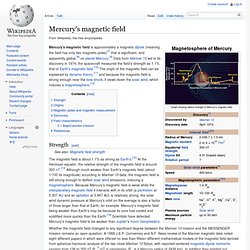
A 1988 J.E.P. Connerney and N.F. Ness review of the Mariner magnetic data noted eight different papers in which were offered no less than fifteen different mathematical models of the magnetic field derived from spherical harmonic analysis of the two close Mariner 10 flybys, with reported centered magnetic dipole moments ranging from 136 to 350 nT-RM3 (nT is nanoteslas, RM is a Mercury radius of 2436 km). In addition they pointed out "[e]stimates of the dipole obtained from bow shock and/or magnetopause positions (only) range from approximately 200 nT-RM3 (Russell 1977) to approximately 400 nT-RM3 (Slavin and Holzer 1979b).
" Origins[edit] This dynamo is probably weaker than Earth's because it is driven by thermo-compositional convection associated with inner core solidification. Magnetic poles and magnetic measurement[edit] Mercury (planet) Mercury is gravitationally locked and rotates in a way that is unique in the Solar System.
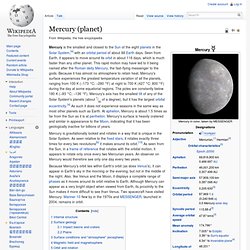
As seen relative to the fixed stars, it rotates exactly three times for every two revolutions[b] it makes around its orbit.[13] As seen from the Sun, in a frame of reference that rotates with the orbital motion, it appears to rotate only once every two Mercurian years. An observer on Mercury would therefore see only one day every two years.
Because Mercury's orbit lies within Earth's orbit (as does Venus's), it can appear in Earth's sky in the morning or the evening, but not in the middle of the night. Also, like Venus and the Moon, it displays a complete range of phases as it moves around its orbit relative to Earth. Mercury as Never Seen Before. Mercury as Never Seen Before Date: 6 Oct 2008.
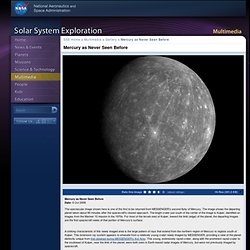
Saturn. Catalog of Transits of Mercury. A transit is the passage of a planet across the Sun's bright disk.

At this time, the planet can be seen as a small black disk slowly moving in front of the Sun. The orbits of Mercury and Venus lie inside Earth's orbit, so they are the only planets which can pass between Earth and Sun to produce a transit. Transits are very rare astronomical events. Cassini Images of Seas on Titan.
Cassini Spacecraft Images Seas on Saturn's Moon Titan Instruments on NASA's Cassini spacecraft have found evidence for seas, likely filled with liquid methane or ethane, in the high northern latitudes of Saturn's moon Titan. One such feature is larger than any of the Great Lakes of North America and is about the same size as several seas on Earth. Cassini's radar instrument imaged several very dark features near Titan's north pole. Much larger than similar features seen before on Titan, the largest dark feature measures at least 100,000 square kilometers (39,000 square miles).
Since the radar has caught only a portion of each of these features, only their minimum size is known. Image right: A comparison view of a lake on Titan and Lake Superior. "We've long hypothesized about oceans on Titan and now with multiple instruments we have a first indication of seas that dwarf the lakes seen previously," said Dr. Chinese moon rover slated for 2012. EO Newsroom: New Images - IMAGE Spacecraft Pictures Aurora. From space, the aurora is a crown of light that circles each of Earth’s poles.
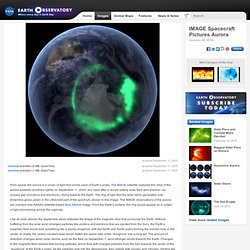
The IMAGE satellite captured this view of the aurora australis (southern lights) on September 11, 2005, four days after a record-setting solar flare sent plasma—an ionized gas of protons and electrons—flying towards the Earth. Cassini Equinox Mission. Huygens CD on Titan. Huygens CD on Titan. Microbes on or within Saturn's moon Enceladus? Microbes on Enceladus?
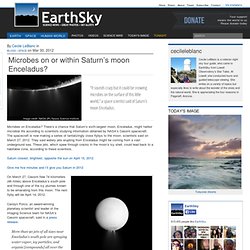
There’s a chance that Saturn’s sixth-largest moon, Enceladus, might harbor microbial life according to scientists studying information obtained by NASA’s Cassini spacecraft. The spacecraft is now making a series of tantalizingly close flybys to the moon, scientists said on March 27, 2012. They said watery jets erupting from Enceladus might be coming from a vast underground sea. These jets, which spew through cracks in the moon’s icy shell, could lead back to a habitable zone, according to these scientists. Saturn closest, brightest, opposite the sun on April 15, 2012 Give me five minutes and I’ll give you Saturn in 2012 Saturn's moon Enceladus has active jets or geysers on its surface that are spewing water into space. Saturn, Sixth Planet from Sun & Second Largest in Solar System. Saturn is the sixth planet from the sun and the second largest planet in the solar system. Although the other gas giants in the solar system — Jupiter, Uranus and Neptune — also have rings, those of Saturn are without a doubt the most extraordinary.
Saturn was the Roman name for Cronus, the lord of the Titans in Greek mythology. Saturn is the root of the English word "Saturday. " Physical characteristics of Saturn Saturn is a gas giant made up mostly of hydrogen and helium. Saturn gets edgy. Observing Saturn through even a small telescope is amazing.

The rings are so obvious and clear that sometimes, when I would show people the planet through my own ‘scope, they thought I was faking the view! But it really is that easy to see them. Well, usually. Saturn, like the Earth, is tilted. That is, if you imagine Saturn orbiting the Sun, the north pole doesn’t point straight up, perpendicular to the orbit. "Amateur" astronomer Alan Friedman — who has taken some incredible pictures of the Sun that have graced this blog — took a series of images of Saturn over several years, and put them together in a very cool animation that shows our changing view of the ringed planet: Pretty nifty [click to encronosenate]! [Again, click to embiggen.] Right now, as the dance of the planets continues, Saturn is getting closer to the Sun in the sky, making it difficult to observe. Image credit: Alan Friedman, used by permission. Related posts: - Ringless - Behold, Saturn!